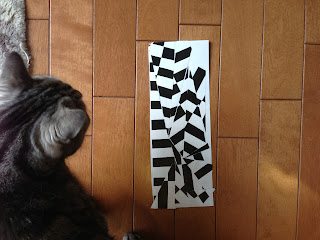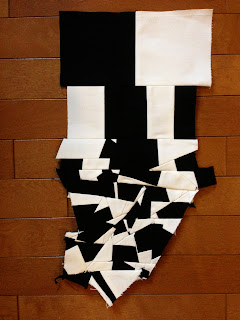Welcome to Chapter 11. Lots of visuals in this blog entry...
Started by photocopying small-print b & w fabric pieces. Used these with earlier printed papers to mix and achieve varying tones. it's hard to judge sometimes which is lighter of darker.
Made blocks, cut, mixed & matched (11.1 ~ 11.6).
11.1 ~ 11.6 Various printed papers arranged in tonal patterns
In 11.7, I tried to create a dark-light-dark pattern. In 11.8 I tried to vary from dark at the top to light at the bottom.
11.7 & 11.8 Further tonal patterns
In 11.9 ~ 11.12, I made further blocks and then cut diagonally, and then mixed and matched.
11.9 ~ 11. 12 Tonal blocks cut diagonally
I made a mistake with 11.13. I just cut the individual patterned papers in a "stack and whack" fashion, mixed and matched and glued down. I later realized that I could/should have done this with the tonal-gradated blocks. Oh, well.
11.13 Simple "stack and whack"
11.14 and 11.15 are other designs with photocopied papers of commercial fabrics and stitched/monoprinted fabrics
11.14
11.15
Then I went back and used the tonal columns to stack and whack again. I was tired of straight lines by the time, so threw in a circle to swap around. I was happy with the result (11.16)!
11.16 A further variation, using stack and whack method
I needed some further bleached fabric. When I tried is a couple of years ago, the black that I had at the time just didn't seem to work with the bleach. It didn't "take." Since then, I bought some other black fabric, so I used that. Wow! It came out a beautiful copper color!
I was very careful to take everything outside and work on the deck in the fresh air, using gloves, and keeping our outside cat well out of harm's way.
Using a variety of tools such as a sponge, cardboard, the cap of the bleach bottle, and the ridges in the deck itself (don't worry, there was plastic underneath the fabric), and always keeping in mind the animal patterns I found wa~y back, I created this piece of patterned fabric to work with (11.17):
11.17 Bleached black fabric
Next step, stitching on the bleached fabric (11.18 ~ 11.22).
11.18 Stitching on bleached fabric
11.19 Details
11.20 Details
11.21 Details
11.22 Details
I then added stitching to some previously dyed fabric (11.23)...
11.23
and some monoprinted fabric (11.24 & 11.25)...
11.24
11.25
while one of the cats, Ten-chan (means "Miss Spot" in Japanese), looked on... (Notice her colors go very well with those of this course ;-)
11.26 shows the final version of one of the assembled samples:
11.26 Finished sample
in this next sample, 11.27, I tried using the stitched solid white fabric between darker pieces that had been cut and stitched. The seams were sewn wrong sides together.
11.27 Dark sample with white bars
This next photo is the final stage of another two pieces I'd made but forgot to photograph before cutting up. First I had a medium-to dark square. Then I took a piece from the bleached black fabric in 11.19 above and cut both of them diagonally. Interlacing them, this is the final sample, hanging on our wall (11.28).
11.28
11.29 Sample (11.28 reverse)
11.30 is sample 11.28 hanging next to one of my favorite dyed fabrics from this course.
11.30
The final (Stage B) sample is a fabric version of "The Challenge" in Chapter 10, but I did not cut diagonally here. I could/should have taken it one step further to cut the bottom piece and continue to cut and stitch which would have given a more complex mixture of tones within that section. Still, looking carefully at the stitching, there are some very interesting patterns in this piece.
- * - * - * - * - * - * - * - * -
Total hours Chapter 11: 16
Safety measures: Care when using bleach, rotary cutter, sewing machine, scissors, iron.... especially around little furry creatures who want your attention!


































